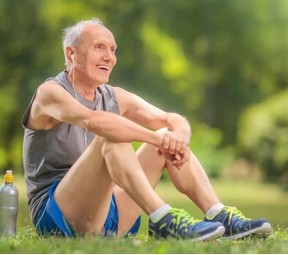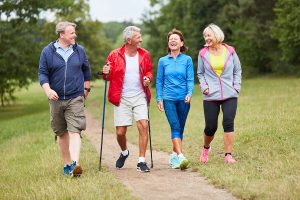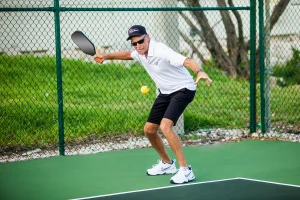6 Chapter Six: Aging in Sport
Kelly McGuire and kimberleymcgrath
Section One: The Fundamentals
A) Keywords
Exercise 1:
Provide a brief definition of one of the padlet keywords for this week.
| The third age is the first of two stages of being a senior citizen. The third age is what I would call a junior senior. A person that is recently retired and enjoying their freedom from a restrictive work schedule but feels they are young enough to be active in physical activities. I would say one of the best times in life.
|
B) The Social Significance of Aging in Sport
Exercise 2: Notebook Prompt
How is old age popularly represented today? Find an image online that you think exemplifies one defining attitude towards old age and paste in your notebook below with a brief explanation of what this image means to you.
 Old age is represented today by the two stages of aging called the third and fourth age. In the third age a person is still active “for their age” and the fourth age of aging is represented as ugly and tragic. Old age is represented today by the two stages of aging called the third and fourth age. In the third age a person is still active “for their age” and the fourth age of aging is represented as ugly and tragic.
The third stage and fourth stage of aging are different for everyone. This image shows a man who would popularly be categorized as being in the third stage of aging but his actual age would put him in the fourth stage. He is very proud of his physical sports ability and is having a much deserved rest.
|
Exercise 3: Notebook Prompt
What does the article (referencing another study by Dionigi) mean by its statement that sport can help aging people to simultaneously “accept and resist the ageing process” (572)? Respond by audio or text and find paste two images sourced online into your notebook showing how sport might help aging people to both accept and resist the aging process.
| “Accept and Resist the ageing process”. Participation in sport can be a daunting thought to many senior citizens. The acceptance component is that as we age we are not as physically capable and agile as in our youth. However acceptance means that age does not negate participation. It is the same approach to sport as when we were young, accept we were not all born Olympic athletes, just do your best and have fun. Resisting the ageing process is important, while there may be limitations in ability it is more important than ever to stay active in your senior years.
 |
Exercise 4: Notebook Prompt
Who are the groups less likely to have extensive opportunities to take part in sports, according to Pike? How does privilege factor into aging and sport? (200 words max)
| According to Elizabeth Pike the groups less likely to participate in sport are those with existing disabilities, weaker and more fragile seniors already living in assisted care, some ethnic groups and those who live outside urban areas.
Privilege is a huge factor in ageing and sport. Access is a factor. Money and time are required to participate in sport. Many people do not have the disposable income required to join leagues and other activities. Time is an issue as many senior help look after grandchildren and their own fourth stage aging parents. Privilege from an earlier time in life would be a factor. If you had the time and money early in life to stay active then that would carry over into your senior years. |
Exercise 5: Padlet Discussion
Why do you think age discrimination is “reported more than any form of prejudice” with older people presented as a threat to social values and interests? Feel welcome to use video in your responses. Paste your comments (or transcript of your video) below!
| Age discrimination is reported more than any other form of prejudice. Elizabeth Pike explains the discrimination is based on the assumption that older people are a threat to social values and interests. In other words senior citizens are a drain on scarce resources. They use up valuable space in healthcare facilities and cost too much because they live on pension income that younger people must contribute to. Also, in a capitalist society older adults are no longer contributing and producing output in gross domestic product and are just a drain on economic resources. Age discrimination is based on seniors value and worth to society. Once you stop producing your worth is depleted.
|
B) Older Women and Sport
Exercise 6: Notebook Prompt
What differences do you see in these ads? Which one is more inclusive? How is age represented or not represented in each? Answer these questions in your notebook.
| These are two different ads. The Nike “you can’t stop us” is focused on participation in sport. Sport can bring people together, sport can be the common denominator in society. This ad is a celebration of sport with athletes from many different backgrounds. There is athlete activism included. Age is represented as young and athletic.
The “this girl can – me again” ad is focused on sport participation by ordinary women, women who don’t have the physique of professional athletes. The ad demonstrates some of the barriers for women to find the time to participate. The ad is meant to encourage women of all ages and abilities to get up and participate. Age is represented as anyone can join, for example when the girl pulls her mom up off the sofa. Both ads are inclusive. |
Exercise 7: Notebook Prompt
In her article, “Assessing the sociology of sport: On age and ability,” Elizabeth Pike references a “trend towards a ‘feminisation of ageing’, with many women living longer than men” (573). Do you agree that aging has been “feminized” in this way? How? Answer these questions in your notebook.
| I do agree with Elizabeth Pike’s reference toward a feminisation of ageing. There are many issues for women and ageing. Based on statistics women do live longer than men and therefore have more years to fulfill with physical activity. For women in general both their third and fourth stage of life will be longer. Another important issue for the feminisation of ageing is that many women carry their family and domestic duties into their senior years. Women continue caretaker responsibilities by looking after the younger and older generations of family. Women often face more financial and confidence challenges.
|
Section Three: Module Mini Assignment
| The great Pickleball debate in Peterborough presents opposing arguments. One side is the argument is to pave over the park to establish more pickle ball courts so third age retired citizens will be more active. The other side opposed to paving presents several arguments, the strongest being the detrimental environmental effects of not leaving the park as open green space.
I think the media introduces pickleball players are as “over the hill” athletes. Agism is an issue, as pickleball is popular with the over 60 population. Pickleball is touted as the new fountain of youth for many third age seniors. Elizabeth Pike explains the current social trend is that seniors can be active in a range of sports. The perception of older adults as frail and on a decline to their fourth age changes with the popularity of pickleball. A factor of agism in this debate is, is priority given to the senior population by changing the landscape of Bonnerworth park. The capacity to play pickleball is a measure of physical ability among the senior population. The pickleball popularity is part of the anti aging agenda as described by Elizabeth Pick. The anti aging agenda is to encourage senior citizens to be active. Elizabeth Pike explains the neoliberal agenda as the push to encourage older adults to stay active which can keep them healthier and therefore not such a drain on social services. The argument to expand pickleballs courts at Bonnerworth park ties directly to a neoliberal agenda. Save Bonnerworth Park as greenspace, pickleball can be played inside.
|

 Acceptance of the ageing process. Pickleball is a less strenuous sport than tennis, it is more acceptable to the ageing population.
Acceptance of the ageing process. Pickleball is a less strenuous sport than tennis, it is more acceptable to the ageing population.